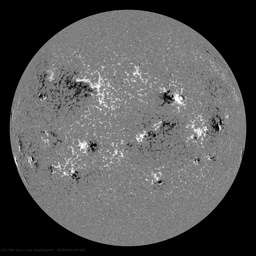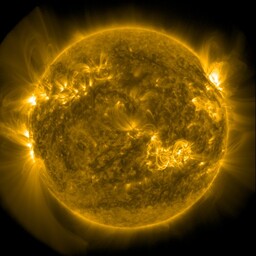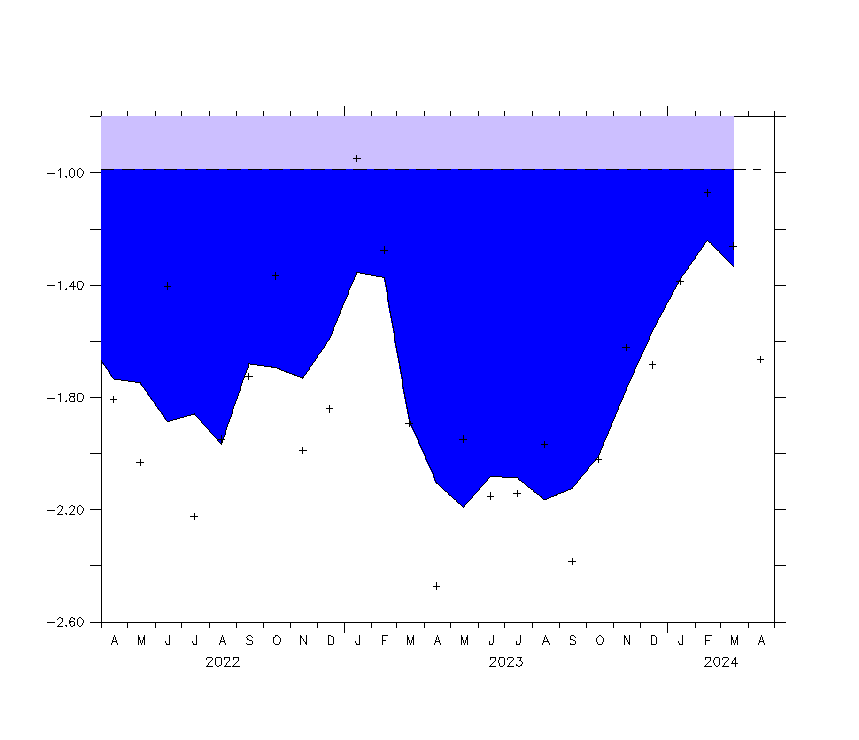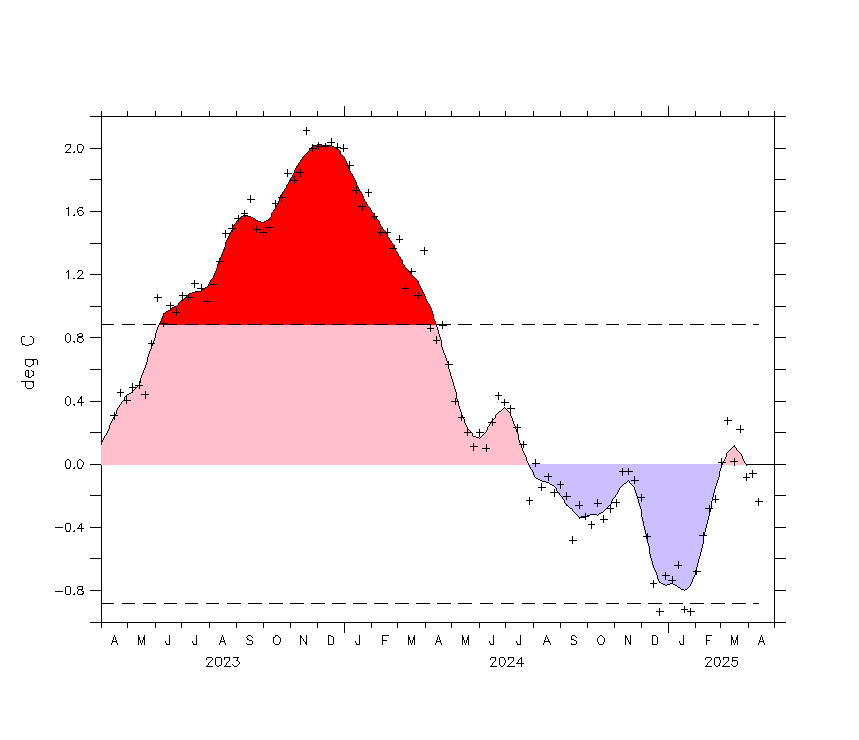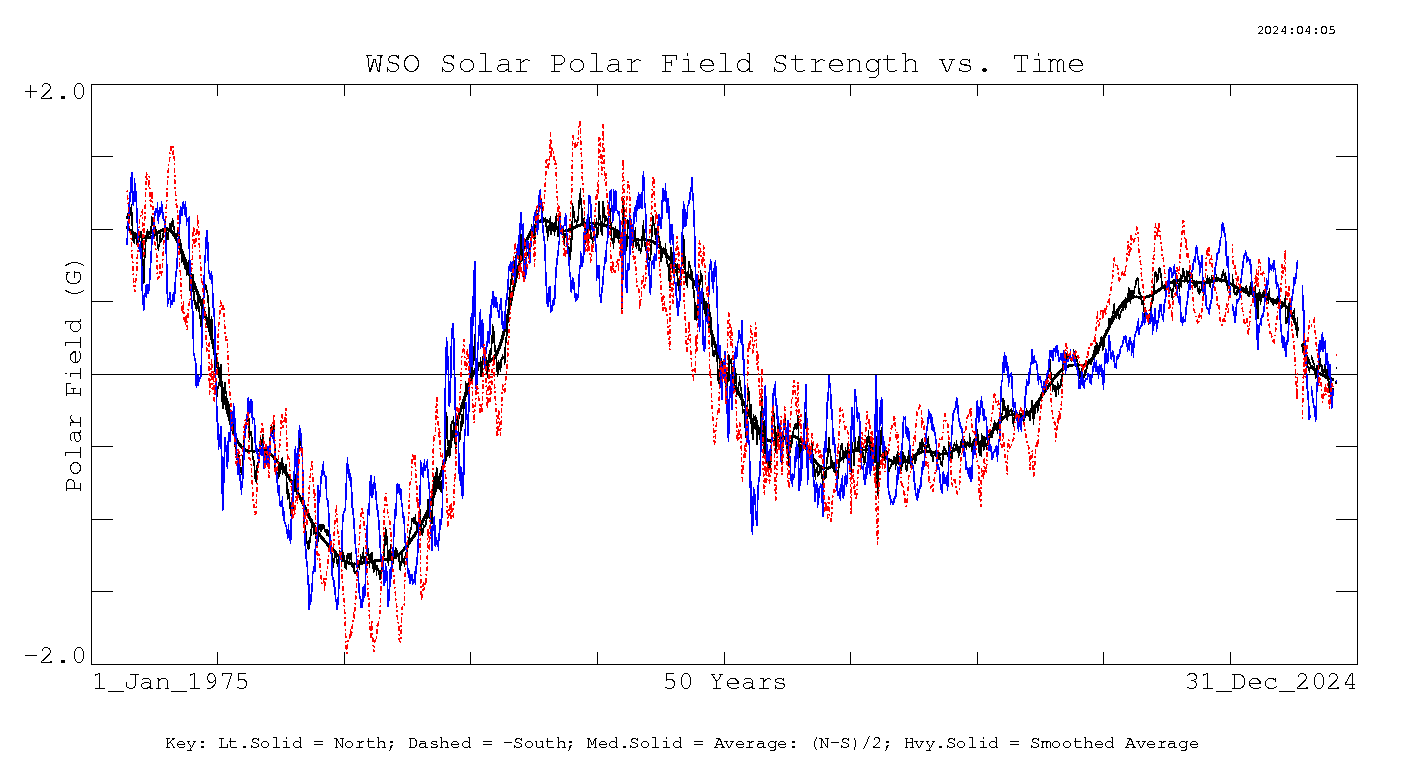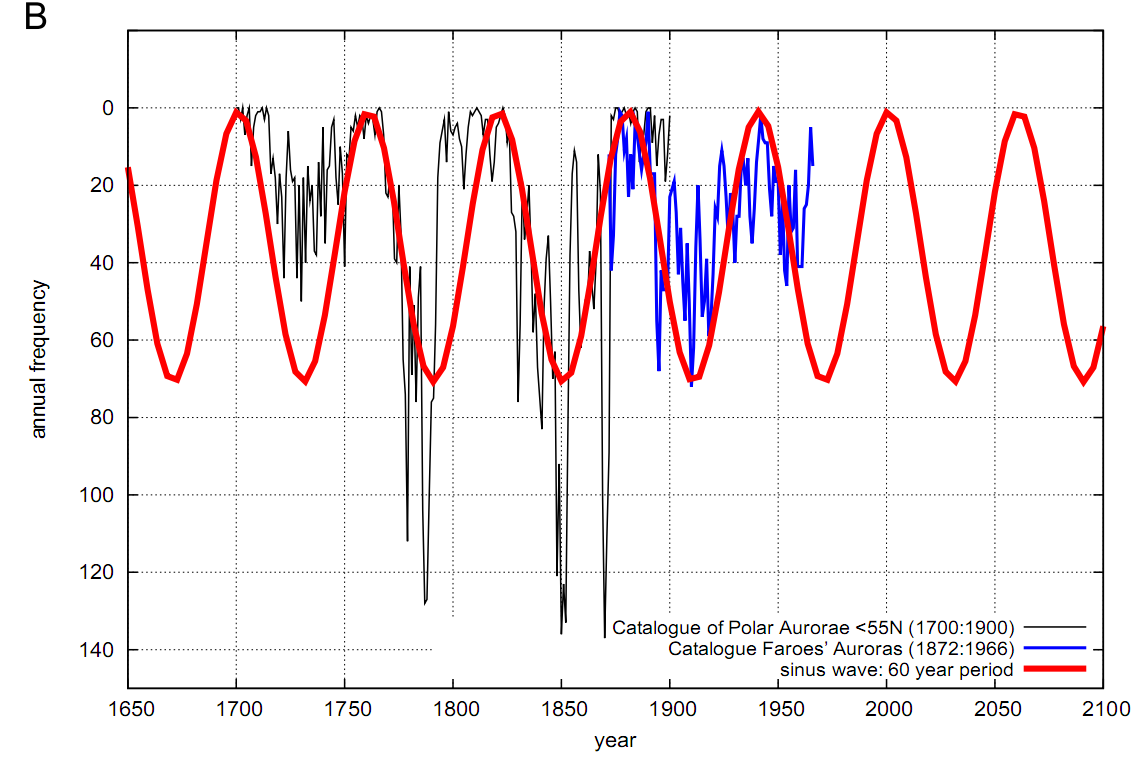
Nicola Scafetta has just sent me a copy of his latest paper "A shared frequency set between the historical mid-latitude aurora records and the global surface temperature"
http://www.sciencedirect.com/science/article/pii/S1364682611002872
The abstract follows:
Herein we show that the historical records of mid-latitude auroras from 1700
to 1966 present oscillations with periods of about 9, 10–11, 20–21, 30 and
60 years. The same frequencies are found in proxy and instrumental global
surface temperature records since 1650 and 1850, respectively, and in
several planetary and solar records. We argue that the aurora records reveal
a physical link between climate change and astronomical oscillations. Likely
in addition to a Soli-Lunar tidal effect, there exists a planetary
modulation of the heliosphere, of the cosmic ray flux reaching the Earth
and/or of the electric properties of the ionosphere. The latter, in turn,
has the potentiality of modulating the global cloud cover that ultimately
drives the climate oscillations through albedo oscillations. In particular,
a quasi-60-year large cycle is quite evident since 1650 in all climate and
astronomical records herein studied, which also include a historical record
of meteorite fall in China from 619 to 1943. These findings support the
thesis that climate oscillations have an astronomical origin. We show that a
harmonic constituent model based on the major astronomical frequencies
revealed in the aurora records and deduced from the natural gravitational
oscillations of the solar system is able to forecast with a reasonable
accuracy the decadal and multidecadal temperature oscillations from 1950 to
2010 using the temperature data before 1950, and vice versa. The existence
of a natural 60-year cyclical modulation of the global surface temperature
induced by astronomical mechanisms, by alone, would imply that at least
60–70% of the warming observed since 1970 has been naturally induced.
Moreover, the climate may stay approximately stable during the next decades
because the 60-year cycle has entered in its cooling phase.
Dr. Scafetta has written several papers on the 60 year trend in global temperatures that align with a 60 year trend in the Solar velocity records. This same trend aligns with the PDO record which is a warm and cool phase of the Pacific Ocean that also aligns with the frequency in the ENSO cycle (whether La Nina or El Nino's dominate). This new paper demonstrates a 60 year period in the mid latitude auroras that suggests a solar output astronomical link in the 60 year cycle.
The theory suggests that during times of low solar output the reduced solar wind allows more cosmic rays to excite the outer atmosphere which then enhance any solar flare activity to a state whereby aurora can be visible at mid latitudes. The 266 year history for the most part does look to show a 60 year fluctuation with perhaps an irregularity around 1950-60. I am not totally convinced with this logic as mid latitude aurora can be a function of an over active Sun also which is in competition. (note: my initial reading of the paper was incorrect, see update below)
The possible causes of the PDO are of immense importance to understanding what drives the world climate and while I am not convinced with the aurora argument (see update) Dr. Scafetta does produce another interesting graph that corresponds very closely with the PDO record.
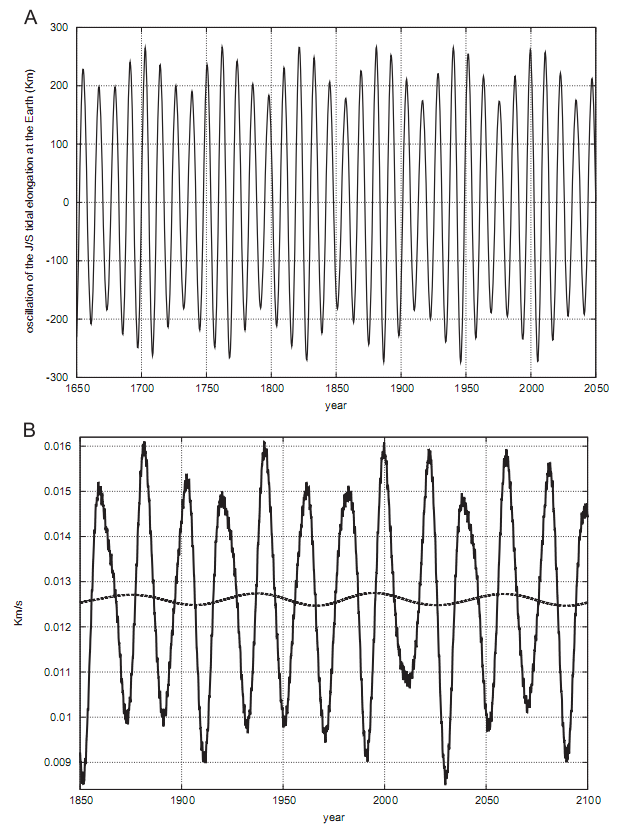
Graph A above displays the tidal effects on Earth from Jupiter & Saturn. A very clear 60 year period is observed which closely aligns with Graph B from his earlier papers that show the modulation of solar velocity. The two forces may be related but are quite distinct from one another. Solar velocity is modulated by the distance the Sun travels away from the SSB (solar system barycentre). The further the distance the faster the Sun travels around the SSB which is totally modulated by Uranus and Neptune. During my research I found the 60 year period came about from the positions of Uranus and Neptune during the Jupiter/Saturn conjunction/opposition. When Uranus/Neptune are together they provide boost (distance) to the Sun and also at other times when either Uranus or Neptune come together with the Jupiter/Saturn conjunction causing a triple conjunction. The last few hundred years shows this 60 year trend in solar velocity but I suspect that might change over longer periods.
Graph A is completely different and shows tidal effects on earth that are not subject to planetary precessions and is far more accurate in my opinion of maintaining a more precise longer lasting 60 year period. The synodic period of Jupiter and Saturn does not vary with planet precession although their perihelion positions will vary over time producing a minor change. In April 2009 I produced a graph that nearly mirrors Nicola's graph A but is based on the Jupiter perihelion/aphelion distances.
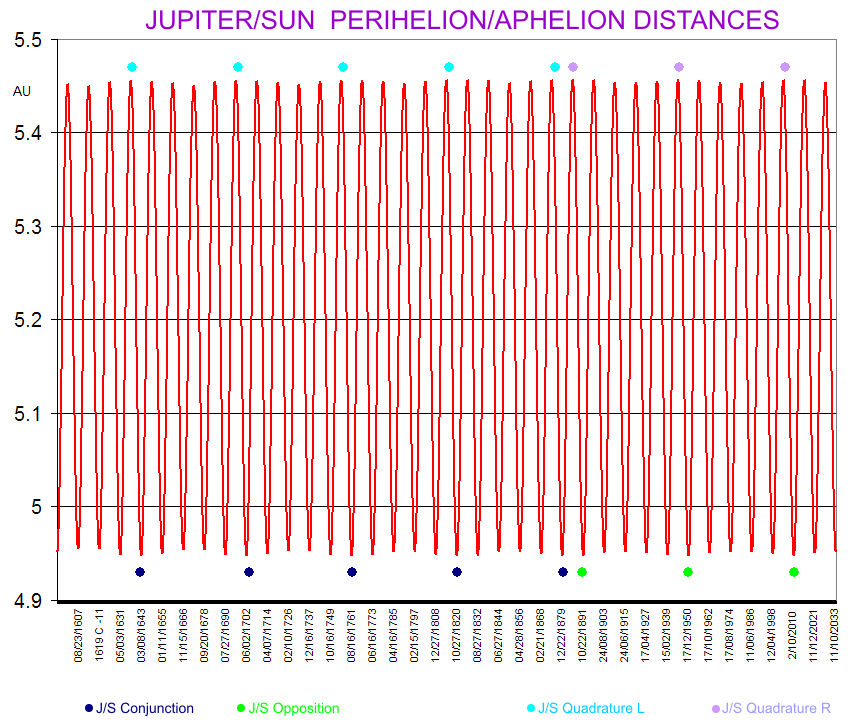
The modulation in Jupiter's perihelion/aphelion distances is mainly brought about in my opinion by the gravitational perturbations induced by Saturn, a link to my original research can be found HERE. I am at odds with many in the scientific community that believe the gas giants do not orbit the Sun. Most I have had discussions with are of the opinion that the outer planets orbit the SSB, but my research strongly suggests at least Jupiter and Saturn have the Sun as their orbit axis point. Whether the Jupiter distance is controlled by planet perturbations or a moving Sun away from the planet axis point there is a modulation of 60 years in the Jupiter perihelion distance that looks to align with the PDO record. Could Jupiter tidal effects somehow control the PDO state? Without a driver we are still in the dark.
Past research on the planet orbit axis points can be found HERE and HERE.
UPDATE: Nov 10 2011.
Dr. Scafetta has pointed out to me that I missed the main point of the mid-latitude aurora driving force. While mid latitude aurora can be a function of increased solar output, the Earth's magnetosphere could be affected by planetary influence in isolation that could have downstream effects on cloud cover. Dr. Scafetta has reported on the quasi 60 year cycle of mid-latitude aurora that corresponds with the Jupiter/Saturn tidal measurements very accurately, but leaves the physical mechanism responsible to others that might like to research further.
On reading the paper there are several references to a planetary influence on the Earth's magnetosphere and how increased cosmic flux excites the outer atmosphere leading ultimately to more mid-latitude auroras (and changes in cloud cover). My reading being from a solar/planetary background was that the planets were affecting solar output thereby influencing the solar wind and ultimately affecting our magnetosphere and cosmic flux levels received. This is not the thrust of Dr. Scafetta's paper which points out a possible planetary effect directly on our magnetosphere. This in my opinion greatly changes the magnitude of what I think is a very important enlightening new paper.
Some extracts from the paper.
Thus, the declination measures the direction of the gravitational and magnetic forces of Jupiter and
Saturn relative to the daily average orientation of the terrestrial magnetosphere.
This returning pattern gives origin to a quasi-60-year physical
tidal cycle on the Sun and in the heliosphere in proximity of the
Earth’s orbit. A similar quasi-60-year periodic pattern would be
generated by the magnetic fields of Jupiter and Saturn that influence
the heliosphere too.
Fig. 9 summarizes a chain of mechanisms that, according to
the finding of this paper, reasonably links the planetary motion to
climate change through solar and heliosphere modulation of the
magnetosphere and ionosphere that regulate the cloud cover
percentage.
It is possible that when Jupiter and Saturn are closer to the Sun,
there may be an increased solar activity because of the stronger
planetary tides and other mechanisms (Wolff and Patrone, 2010),
and a stronger magnetic field within the inner region of the solar
system forms, although the patterns may be more complicated
because of the presence of other cycles that will be discussed in
another paper. A stronger solar or heliospheric magnetic field better
screens galactic cosmic ray fluxes. Fewer cosmic rays reaching the
Earth imply a weaker ionization of the upper atmosphere. As a side-
effect, less auroras form in the middle latitudes because a stronger
magnetic field and a less ionized ionosphere mostly constrains the
auroras in the polar region. In addition, the level of ionization of the
atmosphere has been proposed as an important mechanism that can
modulate the low cloud cover formation (Tinsley, 2008; Kirkby,
2007; Svensmark et al., 2009). Essentially, when the ionization is
weaker, less clouds form. In conclusion, a solar and heliospheric
modulation of the cloud system would greatly contribute to climate
change through an albedo modulation (see Eq. (8)).
Also of interest is the value of using the quasi 60 year aurora/planetary data to forecast future global climate. Below is two graphs from the paper doing just that. The physical mechanism is not required for forecasting if the hindcasting is strong and the planetary future positions are known.
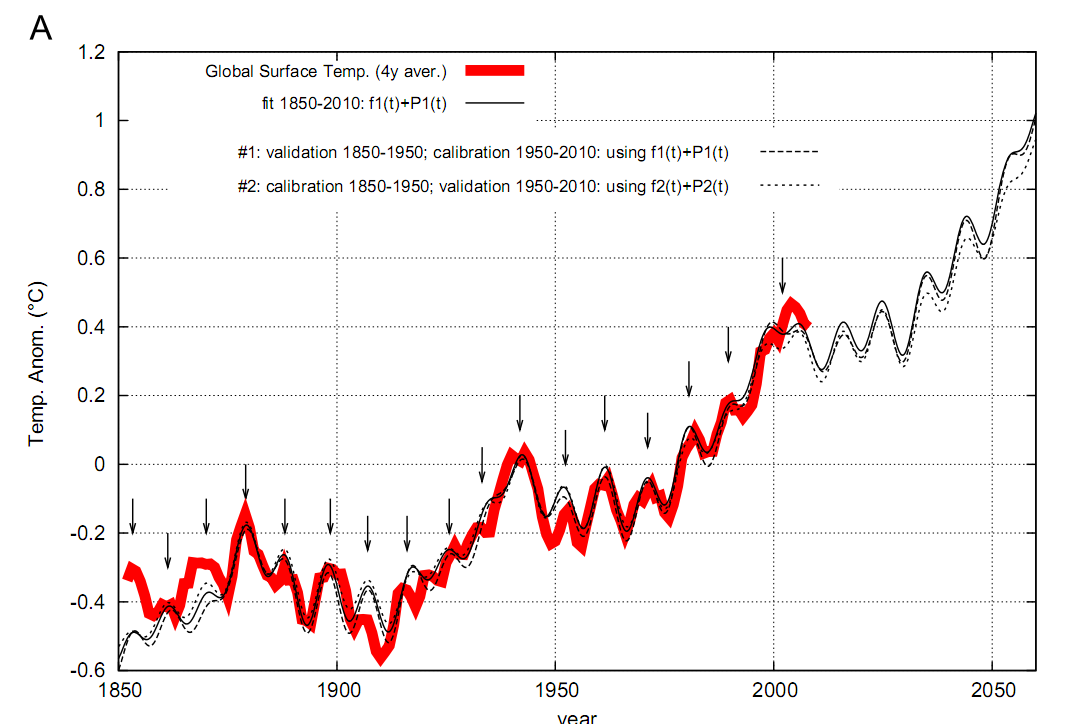
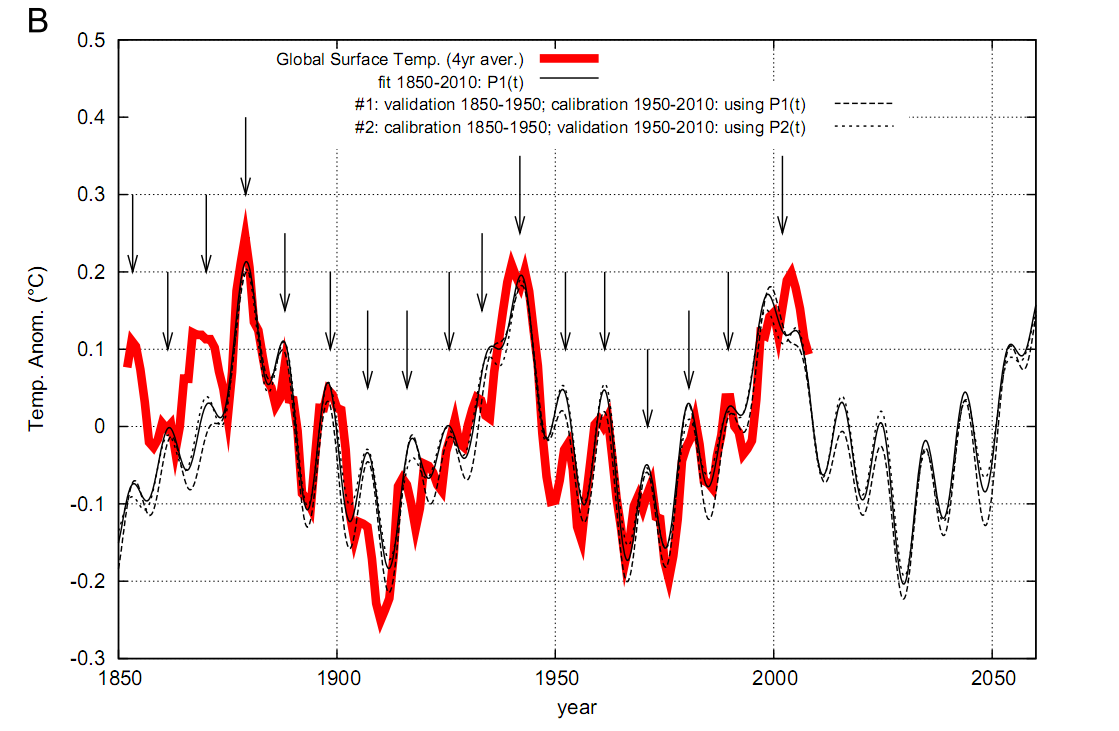
Below is some of the email text from Dr. Scafetta which may serve to explain some of the detail.
What the paper does is to show that the mid-latitude aurora records present the same oscillations of the climate system and of well-identified astronomical cycles. Thus, the origin of the climatic oscillations is astronomical what ever the mechanisms might be.
In the paper I argue that the record of this kind of aurora can be considered a proxy for the electric properties of the atmosphere which then influence the cloud cover and the albedo and, consequently, causes similar cycles in the surface temperature.
Note that aurora may form at middle latitude or if the magnetosphere is weak, so it is not able to efficiently deviate the solar wind, or if the solar explosions (solar flare etc) are particularly energetic, so they break in by force.
During the solar cycle maxima the magnetosphere gets stronger so the aurora should be pushed toward the poles. However, during the solar maxima a lot of solar flares and highly energetic solar explosions occurs. As a consequence you see an increased number of mid-latitude auroras despite the fact that the magnetosphere is stronger and should push them toward the poles.
On the contrary, when the magnetosphere gets weaker on a multidecadal scale, the mid-latitude aurora forms more likely, and you may see some mid-latitude auroras even during the solar minima as Figure 2 shows.
In the paper I argue that what changes the climate is not the auroras per se but the strength of the magnetosphere that regulates the cosmic ray incoming flux which regulate the clouds.
The strength of the magnetosphere is regulated by the sun (whose activity changes in synchrony with the planets), but perhaps the strength of the Earth’s magnetosphere is also regulated directly by the gravitational/magnetic forces of Jupiter and Saturn and the other planets whose gravitational/magnetic tides may stretch or compress the Earth’s magnetosphere in some way making it easier or more difficult for the Earth’s magnetosphere to deviate the cosmic ray.
So, when Jupiter and Saturn get closer to the Sun, they do the following things: 1) may make the sun more active; 2) the more active sun makes the magnetosphere stronger; 3) Jupiter and Saturn contribute with their magnetic fiend to make stronger the magnetic field of the inner part of the solar system; 4) the Earth’ magnetosphere is made stronger and larger by both the increased solar activity and the gravitational and magnetic stretching of it caused by the Jupiter and Saturn. Consequently less cosmic ray arrive on the Earth and less cloud form and there is an heating of the climate.
However, explaining in details the above mechanisms is not the topic of the paper which is limited to prove that such kind of mechanisms exist because revealed by the auroras’s behavior.
The good news is that even if we do not know the physical nature of these mechanisms, climate may be in part forecast in the same way as the tides are currently forecast by using geometrical astronomical considerations as I show in Figure 11.
I am particularly excited that this paper perhaps gives us some insight into the workings of the PDO which I think is the main driver of the global climate system. It may be possible that planetary influence on our magnetosphere influences cloud cover that could determine the spatial SST values that control the PDO, this indeed could be a very big step in our understanding of the climate system.
A copy of the complete paper can be found HERE.


